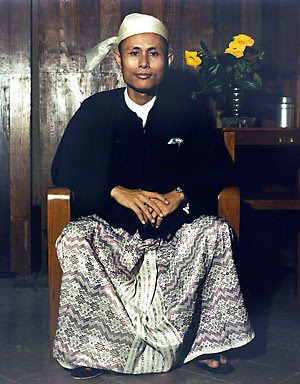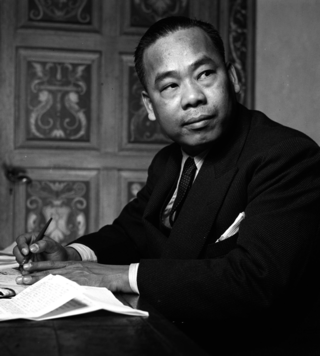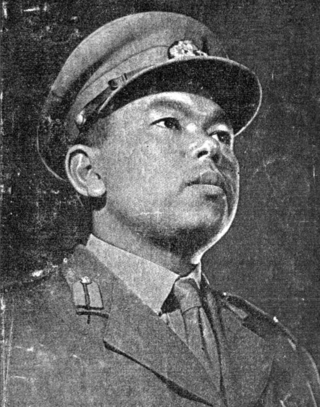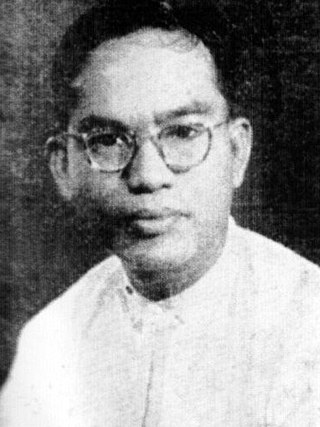The history of Myanmar covers the period from the time of first-known human settlements 13,000 years ago to the present day. The earliest inhabitants of recorded history were a Tibeto-Burman-speaking people who established the Pyu city-states ranged as far south as Pyay and adopted Theravada Buddhism.

Aung San was a Burmese politician, independence activist and revolutionary. He was instrumental in Myanmar's struggle for independence from British rule, but he was assassinated just six months before his goal was realized. Aung San is considered the founder of modern-day Myanmar and the Tatmadaw, and is commonly referred to by the titles "Father of the Nation", "Father of Independence", and "Father of the Tatmadaw".

Nu, commonly known as U Nu and also by the honorific name Thakin Nu, was a leading Burmese statesman and nationalist politician. He was the first Prime Minister of Burma under the provisions of the 1947 Constitution of the Union of Burma, from 4 January 1948 to 12 June 1956, again from 28 February 1957 to 28 October 1958, and finally from 4 April 1960 to 2 March 1962.

The Anti-Fascist People's Freedom League (AFPFL) was the dominant political alliance in Burma from 1945 to 1958. It consisted of political parties and mass and class organizations.

The Burma Independence Army (BIA) was a pro-Japanese and revolutionary army that fought for the end of British rule in Burma by assisting the Japanese in their conquest of the country in 1942 during World War II. It was the first post-colonial army in Burmese history. The BIA was formed from a group known as the Thirty Comrades under the auspices of the Imperial Japanese Army after training the Burmese nationalists in 1941. The BIA's attempts at establishing a government during the invasion led to it being dissolved by the Japanese and the smaller Burma Defence Army (BDA) formed in its place. As Japan guided Burma towards nominal independence, the BDA was expanded into the Burma National Army (BNA) of the State of Burma, a puppet state under Ba Maw, in 1943.

U Saw, also known as Galon U Saw, was a leading Burmese politician who served as Prime Minister of British Burma during the colonial era before the Second World War. He is also known for his role in the assassination of Burma's national hero Aung San and other independence leaders in July 1947, only months before Burma gained independence from Britain in January 1948. He was executed by hanging for this assassination.

Kyaw Zaw was one of the founders of the Tatmadaw and a member of the Thirty Comrades who trained in Japan in the struggle for independence from Britain. He was also one of the leaders of the Communist Party of Burma, and had lived in exile in Yunnan Province, China, since 1989 after retiring from politics.

Thakin Than Tun was a Burmese politician and leader of the Communist Party of Burma (CPB) from 1945 until his assassination in 1968. He was uncle of the former State Counsellor of Myanmar Aung San Suu Kyi.

Thein Pe Myint was a Burmese politician, writer, and journalist. He wrote several politically and socially prominent books and founded the influential newspaper, The Botataung. Thein Pe Myint was a leading Marxist intellectual and an important player in the Burmese independence movement and postwar politics.

Thakin Soe was a founding member of the Communist Party of Burma, formed in 1939 and a leader of Anti-Fascist Organisation. He is regarded as one of Burma's most prominent communist leaders.

The Japanese occupation of Burma was the period between 1942 and 1945 during World War II, when Burma was occupied by the Empire of Japan. The Japanese had assisted formation of the Burma Independence Army, and trained the Thirty Comrades, who were the founders of the modern Armed Forces (Tatmadaw). The Burmese hoped to gain support of the Japanese in expelling the British, so that Burma could become independent.

The State of Burma was a Japanese puppet state created by Japan in 1943 during the Japanese occupation of Burma in World War II.

The first fourteen years of independent Burma (Myanmar) were marred by several communist and ethnic insurgencies. Prominent insurgent groups during this period include the Communist Party of Burma led by Thakin Than Tun, the Communist Party (Burma) led by Thakin Soe, the People's Volunteer Organisation led by Bo La Yaung, the Revolutionary Burma Army (RBA) led by communist officers Bo Zeya, Bo Yan Aung and Bo Yè Htut, and the Karen National Union (KNU).

The Communist Party of Burma (CPB), also known as the Burma Communist Party (BCP), is a clandestine communist party in Myanmar (Burma). It is the oldest existing political party in the country.

The Communist Party (Burma) (Burmese: ကွန်မြူနစ်ပါတီ (ဗမာပြည်)), sometimes referred to as the Red Flag Communist Party (Burmese: အလံနီကွန်မြူနစ်ပါတီ; RFCP), was a communist party in Burma. The party was formed after a more radical faction broke away from the Communist Party of Burma in 1946. In the same year, it began a protracted armed insurgency; first against British rule, then against the Burmese government. The party was led by Thakin Soe, a firebrand communist leader. In the 1970s, the party lost influence and was militarily defeated by 1978.
Thakin Tin Mya was a Burmese politician who served as political commissar in the Seventh Military Region of the Burma National Army.

Anti-fascism is a political movement in opposition to fascist ideologies, groups and individuals. Beginning in European countries in the 1920s, it was at its most significant shortly before and during World War II, where the Axis powers were opposed by many countries forming the Allies of World War II and dozens of resistance movements worldwide. Anti-fascism has been an element of movements across the political spectrum and holding many different political positions such as anarchism, communism, pacifism, republicanism, social democracy, socialism and syndicalism as well as centrist, conservative, liberal and nationalist viewpoints.
Thakin Kyaw Tun, or Thakin Kyaw Dun was a Burmese politician.

Kyaw Nyein, called honorifically U Kyaw Nyein, was a Burmese lawyer and anti-colonial revolutionary, a leader in Burma’s struggle for independence and prominent politician in the first decade after the country gained sovereignty from Britain. He held multiple minister portfolios in the government of Prime Minister U Nu, served as General Secretary of the ruling political alliance, Anti-Fascist People's Freedom League (AFPFL), and was joint General Secretary of the Burma Socialist Party (BSP).

The communist insurgency in Burma was waged primarily by the Communist Party of Burma and the Communist Party (Burma) from 1948 to 1989. The conflict ended when the CPB, severely weakened by an internal mutiny, disbanded its armed wing.


















